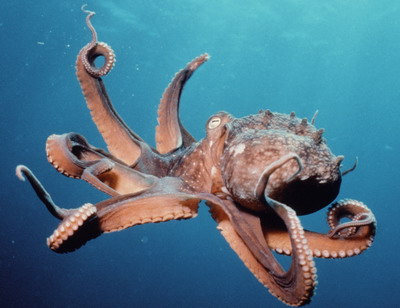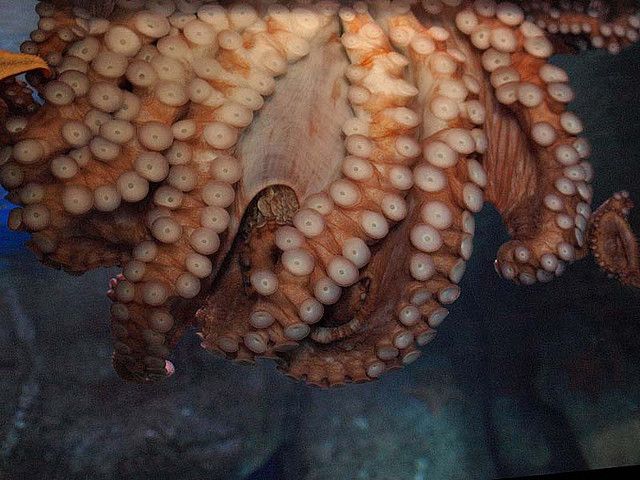Adaptation
To survive in the deap sea, the Enteroctopus megalocyathus has made many great adaptions. Some interesting ones are described below.
Circulatory System
An octopus has three hearts, where two of them pump blood through to the two gills and the other pumps blood to the rest of the body. The blood of an octopus contains a copper-rich protein called hemocyanin that is essential in cold conditions with a low-oxygen pressure to transport oxygen. Instead of being carried by red blood cells, the hemocyanin dissolves in plasma giving the blood a blue color (Conners, 2012).
The eight arms of an octopus are essential in how it moves around and captures prey. The muscle combination of radial and longitudinal makes the arms very strong (Hartis, 2011). The two rear arms are for walking like legs and the other six arms are used for grabbing objects. An octopuses arms are able to resist one-hundred times its weight but because they are so large, it is hard for an octopus to learn the detailed effects of its motions. The only way for it to know what motions the arm has performed, is by physically seeing them do it.
Brain
Octopuses are possibly one of the most intelligent invertebrates known to man. The octopus brain is shown to have a complex nervous system. Only one third of the neurons are found in the brain while the rest are found in the nerve cords of its arms, which have functional limitations. This means that the motor skills are not organized in their brain instead using a nonsomatopic system (Zullo, L. and B. Hochner). Short term and long term memory have been found to exist in the vertical lobe of the brain (Hochner et al. 2003). Octopuses learned to board fishing boats and open holds to eat crabs. They have also been observed to learning to play; releasing bottles and then catching them. Learning is a large part of the octopus’s life because young octopuses have very little contact with their parents, leaving behavior to be learned on their own.
Eyes
The eyes of an octopus are very complex including fully
established retinas and optic lobes, a lot like humans. However,
they focus by moving their lens in and out rather then changing
shape like a human (MarineBio, 2013). Although they have great
eyesight, they would be able to get around without it if they
had to due to their great sense of touch.
Suckers
The suckers of an octopus are circular and muscular. Unlike a squid they do not have any teeth or hooks. Suckers are located all along the arms or "tentacles" in two rows. They have a good, strong suction allowing them to latch onto surfaces. These suckers are also very good at sensing their environment since they have countless chemical receptors making them sensitive to touch, especially around the rim (Hartis, 2011). A blindfolded octopus can differentiate between various shaped and sized objust just as well as a sighted octopus (MarineBio, 2013). Not to mention that their long, strong arms are helpful in pushing them up off of the ocean floor so they can swim. An octopus also uses its suckers to catch and latch onto prey.
Chromatophores
Avoiding predators and catching prey are both very essential for the survival of any organism. Chromatophores are pigmented cells that are located all over the body of an octopus and when expanded will change color. The change in color can be caused by danger, emotion or hormones. Chromatophores are a great way to hide from a predator or even sneak up on prey. At times this species will stroll the ocean floor while its chromatophores are expanded, causing it to blend into the environment and attack its prey. Watch the video below to see the chromatophores in action!
Ink
Another way that this species may avoid a predator is by swimming away or ejecting ink. Most of the time this species will try to fight off whatever is attacking it by using its arms or swimming away, but it some cases it will eject ink. The ink that is ejected is toxic so when in a confined space with it, it could make an organism very ill or kill them. When the octopus ejects the ink it weakens the taste and odor of the predator while also discharging a burst of water, creating a cloud and further confusing the predator so that it can escape (Hartis, 2011).
Tools
By using their learning skills octopuses like the Patagonia Red Octopus have made tools out of ordinary objects they find. They have been seen using rocks/coral to barricade their dens. Another example is the use of coconut shells as shelter and form of transportation from thee Amphioctopus marginatuss. There is no protective benefit from the shell(s) when the octopus is carrying it for the head and body are fully exposed. The only benefit is from future placement of the shell (Finnn et all., 2009). Watch the video below to see this tool at work!!


